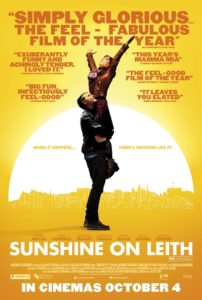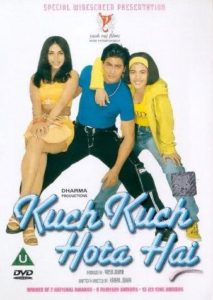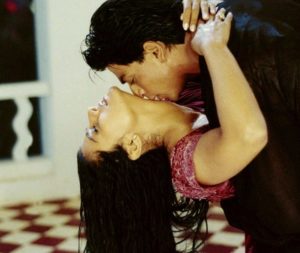HNC Photography, IFC - Coursework, Introduction to Film Culture Blog, Part five - Suspension of disbelief, Project 2 - Song and dance routine
Compare Bollywood musical Kuch Kuch Hota Hai (Karan Johar, 1998) and Sunshine on Leith (Dexter Fletcher, UK, 2013).

The musical genre of film has been popular since the early 20th century, becoming one of the dominant genres in Hollywood and national cinemas alike as a result of its ability to project aesthetic and social values (Nelmes, 2012). As such, Etherington-Wright and Doughty (2011) have linked the understanding of the genre to cultural competency, particularly in relation to Bollywood, the Indian national cinema that is fundamentally based upon its use of music. However, Bordwell and Thompson (2003, p. 110) point out that musicals are somewhat unfashionable. Although this assertion was made prior to 2016 release of the highly popular La La Land (Damien Chazelle, 2016) it is necessary to assess the extent to which the musical genre within Bollywood and outside of it has lost its status as a spectacle as well as how far the content has altered to address modern audiences. This will be done via the assessment of the Bollywood musical Kuch Kuch Hota Hai (1998) and British movie Sunshine on Leith (2013) in order to text the thesis that modern musicals inside and outside India are still cultural phenomena that may be used to reflect issues that impact upon modern audiences effectively.
Kuch Kuch Hota Hai and Sunshine on Leith are very different examples of musicals for a variety of reasons. Firstly, the latter is a jukebox musical that exclusively features the songs of The Proclaimers, thus marking a modern form of the genre that is more of a hybrid of a concert and a movie in order to appeal to contemporaneous audiences in order to provide “…a certain narcissistic gratification by evoking memories… and in the process making your own past a part of the performance” (Savran, 2011). This is reinforced by the opening scene, which does not adhere to musical conventions in the traditional sense. Instead, it depicts a British Army battalion being ambushed, within which protagonists Ally and Davy sing “Sky Takes the Soul”. As such, it taps directly into modern events whilst evoking a diverse range of memories from the audience with the use of a popular song. It is far from a spectacle but is instead grounded in reality. On the other hand, Kuch Kuch Hota Hai features a more traditional Bollywood soundtrack in that it was written specifically for the movie and appears to adhere to other traditional Bollywood conventions. For example, the montage that appears at the very start of the movie to introduce the audience to the narrative and characters is highly colourful and establishes the tragedy on which Rahul can ultimately journey towards the “narrative closure” (Desai, 2004) of the typical happily ever after ending. In this sense, Kuch Kuch Hota Hai and Sunshine on Leith appear to be products of their own national cinemas and have a very different tone, outlook and subject. However, it is clear that both seek to build upon the traditional musical forms, thus suggesting that the musical both within and outside of India lend the genre significance but do so as a result of the change in content rather than despite it.
In terms of the shift in content to reflect the altered expectations of a modern audience, the narratives and stylistic traits of both movies, whilst very different from each other, tap directly into modern and rather globalist sensibilities that challenge tradition and existing cultural hierarchies. Indeed, Kuch Kuch Hota Hai is one of the recent Bollywood movies that is indicative of the national cinema’s shift towards globalisation, blurring the categories that separate the Western and Bollywood traditions in order to achieve a crossover appeal (Desai, 20 04, p. 41). However, Villarejo (2013) asserts that “Bollywood recycles, adapts, translates and otherwise incorporates diverse material into its stories, remaking Hollywood films, remixing or reinterpreting its own successes, and responding to increased interest from spectators around the world…” This directly challenges the notion that the musical is not an international genre, but rather a local one (Altman, 1996). For example, the romantic narrative is a universal one that diverse audiences may understand and relate to but also examines ideas of national identity without directly challenging them (Gopalan, 2012). This is evident in the resolution of Kuch Kuch Hota Hai. Rahul’s interruption of Anjali’s wedding would normally be problematic in Indian culture because it actively challenges masculine authority and the ideal of marital harmony. However, Aman’s decision to step aside and release her from the engagement cleverly negates this problem, thus emphasising agency and reinforcing patriarchal values. This is paired with the celebration of Indian culture via the wedding itself. As such, there is a fine balance between appealing to modern audience and maintaining Bollywood traditions. In this respect, this movie can be characterised as a key component of modern Bollywood as a cultural phenomenon.
04, p. 41). However, Villarejo (2013) asserts that “Bollywood recycles, adapts, translates and otherwise incorporates diverse material into its stories, remaking Hollywood films, remixing or reinterpreting its own successes, and responding to increased interest from spectators around the world…” This directly challenges the notion that the musical is not an international genre, but rather a local one (Altman, 1996). For example, the romantic narrative is a universal one that diverse audiences may understand and relate to but also examines ideas of national identity without directly challenging them (Gopalan, 2012). This is evident in the resolution of Kuch Kuch Hota Hai. Rahul’s interruption of Anjali’s wedding would normally be problematic in Indian culture because it actively challenges masculine authority and the ideal of marital harmony. However, Aman’s decision to step aside and release her from the engagement cleverly negates this problem, thus emphasising agency and reinforcing patriarchal values. This is paired with the celebration of Indian culture via the wedding itself. As such, there is a fine balance between appealing to modern audience and maintaining Bollywood traditions. In this respect, this movie can be characterised as a key component of modern Bollywood as a cultural phenomenon.
Sunshine on Leith is significantly different in this respect. It typically abandons musical conventions in favour of an honest and realist approach to life in modern Britain. This is evident in the mise en scene. For example, Ally returns home and has to share a cramped room with his nephew. He also meets Davy in a dingy and rather traditional pub. Both of these settings illustrate the reality of modern life in Scotland rather than the idealised lifestyle that is often projected within the traditional movies of the musical genre (Altman, 1996). However, this does have a transformative value later in the movie, specifically where Sunshine on Leith does share a specific feature with Kuch Kuch Hota Hai – the happily ever after.  The streets of Edinburgh are framed in a positive light when Davy chases Yvonne to prevent her from leaving the city by declaring his love for her. Place and identity are therefore key elements of the narrative and the aesthetics of the movie, positioning it in terms of the national whilst appealing to the universalist sensibilities of the modern audience, thus framing it as a cultural phenomenon in a similar way to Kuch Kuch Hota Hai. As such, this suggests that the musical has not been diminished since the golden age of Bollywood and the Hollywood studio spectacle, but rather that the musical genre is a significant cultural phenomenon that is able to adapt to current events within the framework of national cinema but appeals to a global audience.
The streets of Edinburgh are framed in a positive light when Davy chases Yvonne to prevent her from leaving the city by declaring his love for her. Place and identity are therefore key elements of the narrative and the aesthetics of the movie, positioning it in terms of the national whilst appealing to the universalist sensibilities of the modern audience, thus framing it as a cultural phenomenon in a similar way to Kuch Kuch Hota Hai. As such, this suggests that the musical has not been diminished since the golden age of Bollywood and the Hollywood studio spectacle, but rather that the musical genre is a significant cultural phenomenon that is able to adapt to current events within the framework of national cinema but appeals to a global audience.
In conclusion, the analysis here indicates that Kuch Kuch Hota Hai and Sunshine on Leith are two very different movies in terms of their position within the musical genre and actively appeal to their national audiences via very distinctive features, many of which are typical of the genre, such as the mise en scene and the nature of the narratives. However, despite their aesthetic differences, there is a sense that they tap into a broader framework of cultural phenomena that use the national to tap into globalist agendas that are driven by commercialism and the nature of modern life. The content undoubtedly addresses modern audiences in terms of the experiences the characters endure and the way in which they relate to the individual viewers, although the differences between the usage of music highlights the disparities between the cultures that underpin each movie. As such, the analysis here reinforces the thesis that modern musicals, both inside and outside India, are still relevant to society, tapping into experiences and the reality of modern life. In this way, they actively appeal to audiences and provide evidence of cultural phenomena that may be used to reflect issues that impact upon modern viewers effectively.
Bibliography
Altman, R., (1996). Cinema and Genre. In G. Nowell-Smith ed. The Oxford History of World Cinema. Oxford: Oxford University Press, pp. 276-285.
Bordwell, D. & Thompson, K., (2003). Film Art: An Introduction. Boston: McGraw-Hill.
Desai, J., (2004). Beyond Bollywood: The Cultural Politics of South Asian Diasporic Film. Cambridge: Psychology Press.
Etherington-Wright, C. & Doughty, R., (2011). Understanding Film Theory. Basingstoke: Palgrave Macmillan.
Gopalan, L., (2012). Indian Cinema. In J. Nelmes ed. Introduction to Film Studies. Abingdon: Routledge, pp. 399-425.
Kuch Kuch Hota Hai, (1998). [Film] Dir. by K. Johar. India: Dharma Productions.
Nelmes, J., (2012). Introduction. In J. Nelmes ed. Introduction to Film Studies. Abingdon: Routledge, pp. xxi-xxv.
Savran, D., (2011). Class and Culture. In R. Knapp, M. Morris & S. Wolf eds. The Oxford Handbook of the American Musical. Oxford: Oxford University Press, pp. 239-253.
Sunshine on Leith, (2013). [Film] Dir. by D. Fletcher. UK: BFI.
Villarejo, A., (2013). Film Studies: The Basics. Abingdon: Routledge
